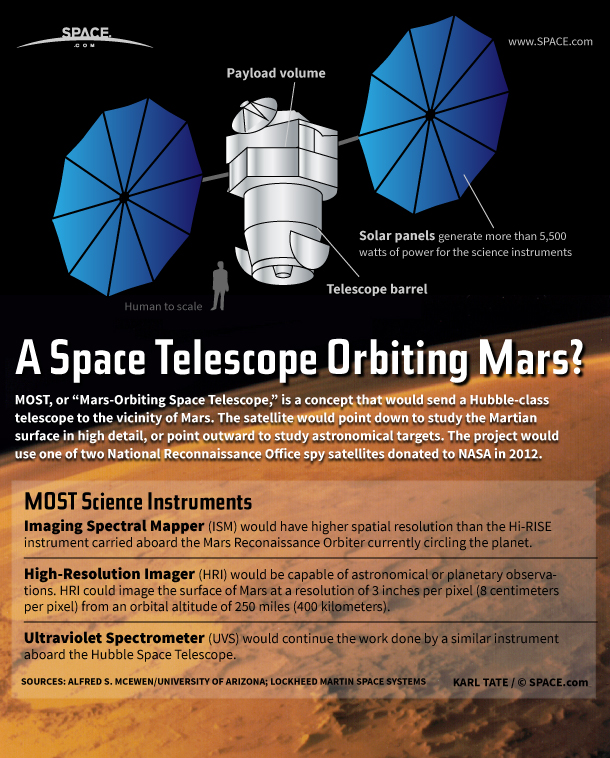A Space Telescope Around Mars? How Old Spy Satellite Tech Could Do It (Infographic)

MOST, or the "Mars-Orbiting Space Telescope," is a concept that would send a Hubble-class telescope to the vicinity of Mars. The instrument would point down to study the Martian surface in high detail, or point outward to study astronomical targets. The project would use one of two National Reconnaissance Office spy satellites donated to NASA in 2012.
MOST would include three main science instruments:
The Imaging Spectral Mapper (ISM) would have higher spatial resolution than the HiRISE instrument carried aboard the Mars Reconnaissance Orbiter currently circling the planet.
The High-Resolution Imager (HRI) would be capable of astronomical or planetary observations. HRI could image the surface of Mars at a resolution of 3 inches per pixel (8 centimeters per pixel) from an orbital altitude of 250 miles (400 kilometers).
The Ultraviolet Spectrometer (UVS) would continue the work done by a similar instrument aboard the Hubble Space Telescope.
NASA Mulls Missions for Donated Spy Satellite Telescopes
MOST's instruments would enable observation of astrophysical and planetary targets as well as Mars' surface, upper atmosphere and aurora phenomena. The mission would continue work done by NASA with the Hubble Space Telescope and would complement the capabilities of other planned space telescopes including the James Webb Space Telescope.
Breaking space news, the latest updates on rocket launches, skywatching events and more!
- Gallery: Declassified US Spy Satellite Photos & Designs
- Most Amazing Hubble Discoveries
- How the Hubble Space Telescope Works (Infographic)
- Hubble Quiz: Do You Know the Famous Space Telescope?
Follow us @Spacedotcom, Facebookand Google+.

Karl's association with Space.com goes back to 2000, when he was hired to produce interactive Flash graphics. From 2010 to 2016, Karl worked as an infographics specialist across all editorial properties of Purch (formerly known as TechMediaNetwork). Before joining Space.com, Karl spent 11 years at the New York headquarters of The Associated Press, creating news graphics for use around the world in newspapers and on the web. He has a degree in graphic design from Louisiana State University and now works as a freelance graphic designer in New York City.
